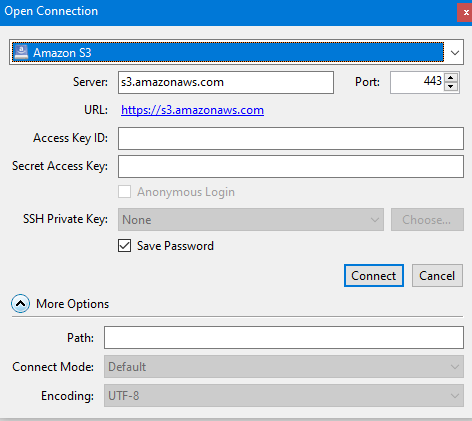
You will then see you have access to the files on you EC2 instance in AWS. pem file from the location you saved it then click “Connect”. pem file when you create your EC2 instance.

When you do this you will see the option to choose the file from your computer. Next you need to check the “Use Public Key Authentication” checkbox. If you are using Ubuntu, then you need to use “ubuntu” as the “Username” If you have a Linux instance running, you will need to use “ec2-user” as the “Username” in Cyberduck. Then enter the “Public DNS” of your EC2 instance into the “Server” field in Cyberduck and the “Username” Top tip. Open Cyberduck and click on “Open Connection” It will be formatted something like this:Į.com
CYBERDUCK AWS INSTALL
Because a distribution package doesn’t include the Python interpreter, it makes the download and install about 2-12 MB smaller than freezing your application.
CYBERDUCK AWS CODE
Take the “Public DNS” data from the “Public DNS” column. Creating a Linux distro package is arguably the right way to distribute code on Linux. Log in to your AWS console and click on “EC2” pem file (public key) which you will have received when you created your EC2 instance All you need us the Public DNS of your EC2 instance and.

CYBERDUCK AWS FOR MAC
Cyberduck is a popular FTP, SFTP, WebDAV, S3 & Openstack Swift browser for Mac & Windows (it was originally for Mac only so is popular amongst Mac users).It’s incredible easy to access an AWS EC2 instance using Cyberduck.So, my Key was wrong because my Bucket was wrong. The request signature we calculated does not match the signature you The error message does actually point out the issue: If they do not match exactly on both the calling client, and within AWS, then the request will be denied with a 403. The way the Signature works is fairly complicated, but the issue boils down to the bucket and key are used to generate the encrypted signature. This shows that the / I provided to my Bucket parameter has been through urlencode() and is now %2F. After further inspection of the exact message I was receiving from the SDK, I found this: What I believe is happening is that the Bucket name is now being URL Encoded. 'Key' => 'catsinhats/whitecats/white_cat_in_hat1.png',

I had to move the catsinhats portion of my bucket/key path to the Key parameter, like so: $s3Client = new S3Client([ 'Key' => 'whitecats/white_cat_in_hat1.png',
/assets/images/2899545/original/cyberduck05.png)
Today I spent the better part of two hours debugging why I had started receiving this error, and it ended up being due to the parameters I was passing (which used to work): $s3Client = new S3Client([ Since the factory method still worked, I did not revisit this module after updating to ~3.70.0. I had a file manager in production use, using the v2 SDK. In a previous version of the aws-php-sdk, prior to the deprecation of the S3Client::factory() method, you were allowed to place part of the file path, or Key as it is called in the S3Client->putObject() parameters, on the bucket parameter. profile and including credentials in code) but nothing is working at the moment. I've already checked my access key and secret at least 20 times, generated new ones, used different methods to pass in the information (i.e. The request signature we calculated does not match the signature you provided. overriding 'default_settings' with our default credentials and All AWS clients extend from 'default_settings'. Bootstrap the configuration file with AWS specific features My config.php file is as follows: return [ Get the client from the service locator by namespace I am trying to connect to my Amazon S3 bucket with the following code: // Create a `Aws` object using a configuration file I am on AWS SDK for PHP V2.8.7 running on PHP 5.3. I have searched on the web for over two days now, and probably have looked through most of the online documented scenarios and workarounds, but nothing worked for me so far.


 0 kommentar(er)
0 kommentar(er)
